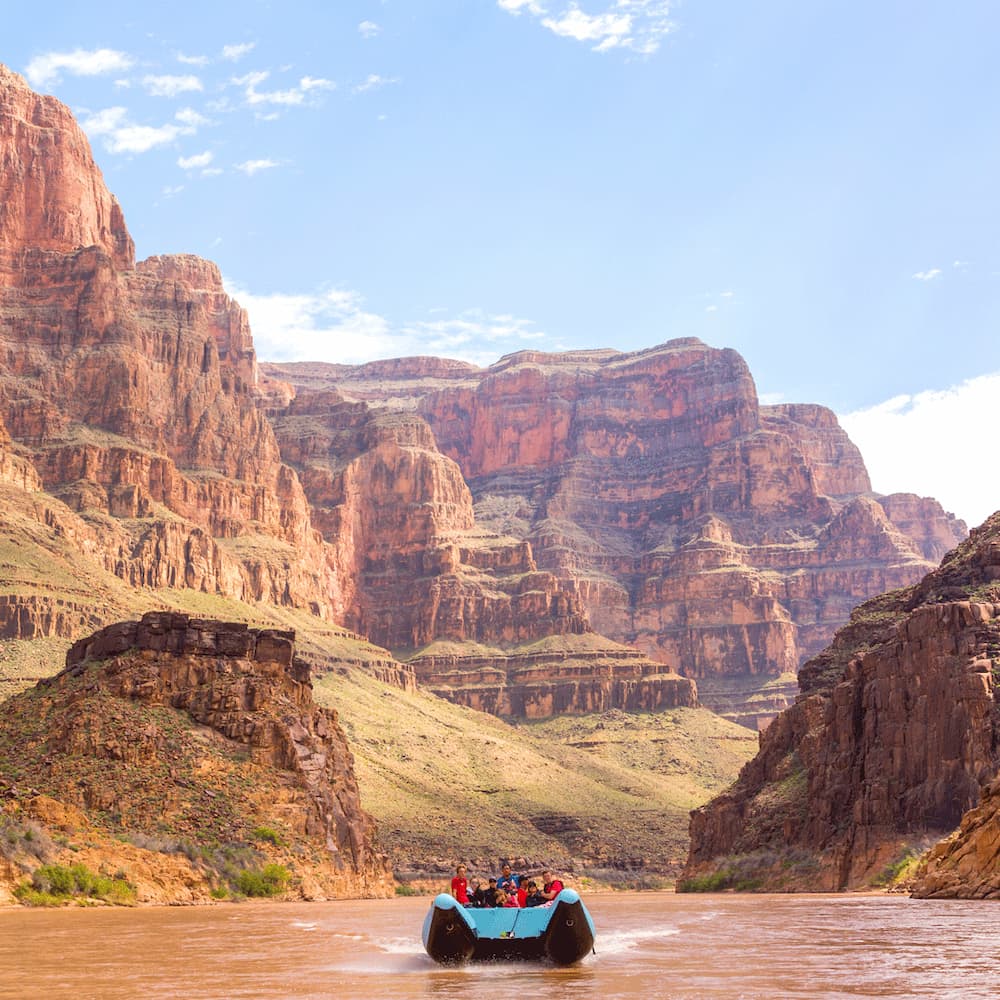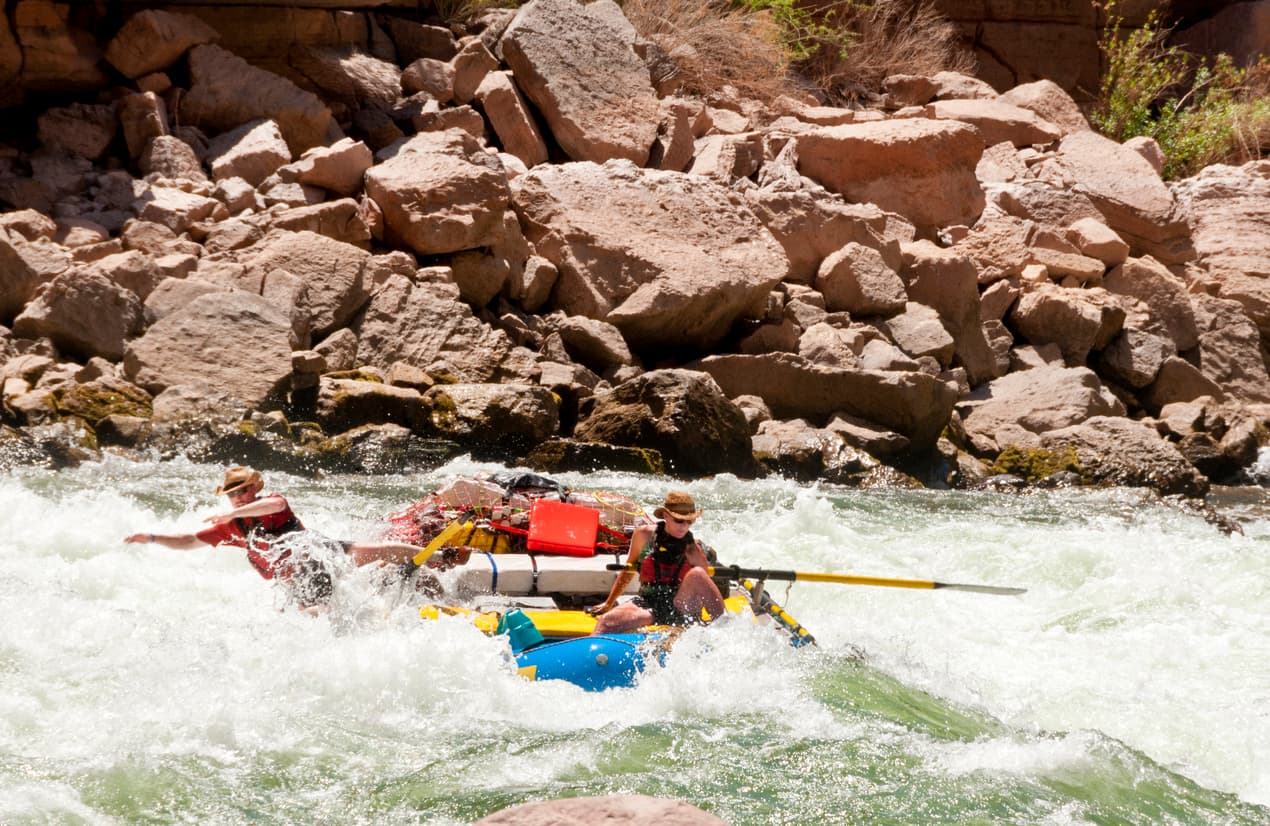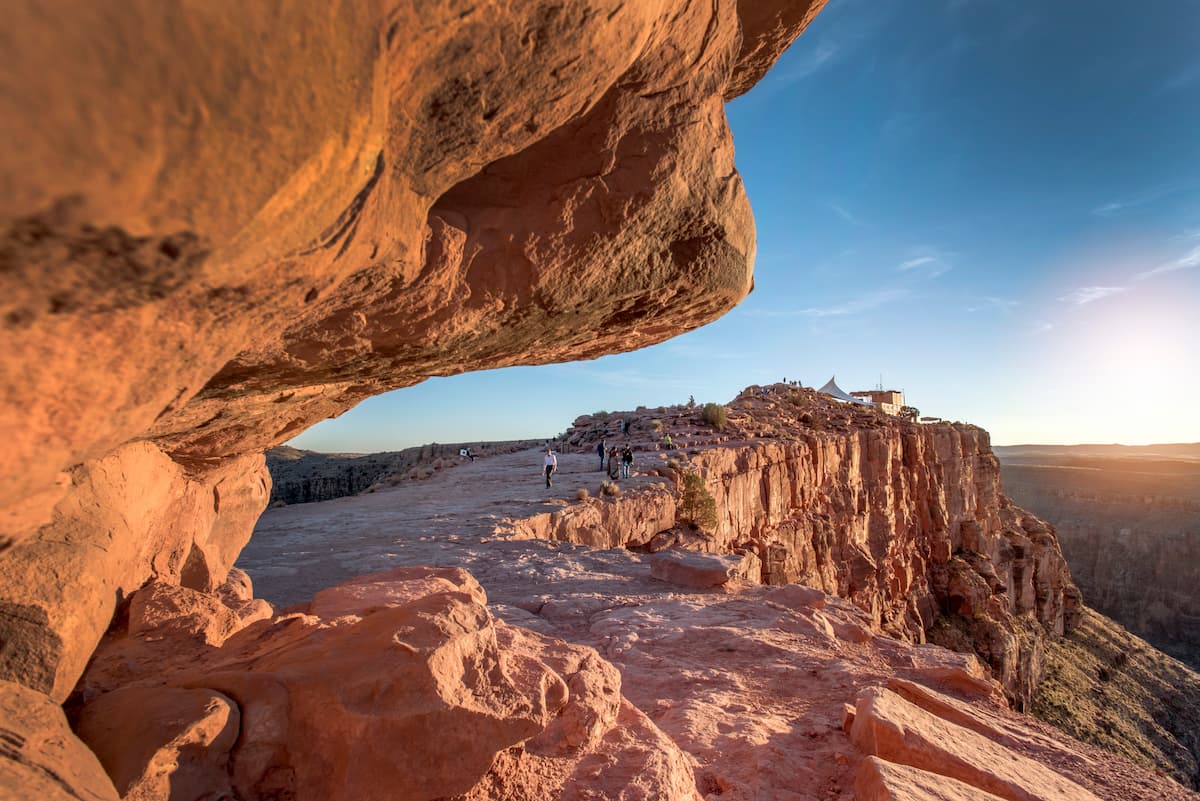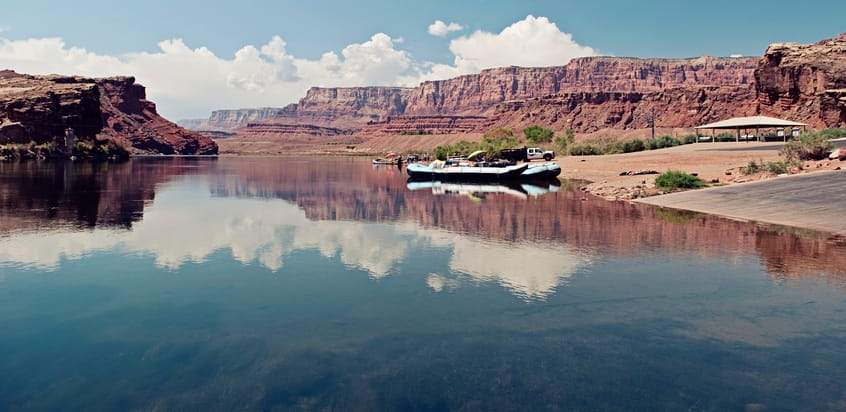Rafting vs. Hiking the Grand Canyon
Most people meet the Grand Canyon from a pullout on the rim. It is breathtaking, no doubt. Yet there is another side to this place that changes the scale, the sound, and even the temperature of the day. Rafting the Colorado River puts you inside the walls with cool spray and sand underfoot. Hiking drops you through rock layers with every switchback, legs burning, horizons widening. Both are powerful, and they are not the same.

How Each Experience Feels
Rafting is a full-body sensory event. The raft flexes beneath you. Rapids rumble long before you see them. Cold water shocks the skin. Between rapids, there is calm water and warm sun, the near-constant hush of the river against shore, and the green scent of willows and cottonwoods.
Hiking plays out in heat and silence. Wind and ravens carry sound in waves, then the only noise is your breath. The trail rises and falls beneath a steady rhythm of footfalls. On the rim, you feel exposed to distance. Below the rim, the walls pull inward and the sun reflects off stone, warming every step.
Both modes offer awe, they just deliver it from different angles.
Effort, Time, and Logistics
Rafting and hiking ask for different kinds of work. One concentrates effort into bursts; the other keeps a steady demand for hours.
- Rafting on one-day motor boats asks for agility and attention, not constant paddling. Two-day rafting trips are more active, with everyone paddling through rapids on day one, then relaxing floats later.
- Hiking asks for continuous effort. You carry water and food, manage heat, and climb steep grades for long stretches. National Park Service guidance is direct about this — Grand Canyon hikes are much harder than most people expect.
Here is a side-by-side snapshot:
| Attribute | Rafting | Hiking |
| Physical Demand | Intermittent effort — bracing in rapids, short side hikes, loading camp gear on multi-day trips. | Continuous effort — steep grades, heavy packs, heat management, long descents followed by long climbs. |
| Typical Duration | 1-day motor trips to 2-day paddle trips with Grand Canyon West. | 4 to 8 hour day hikes. |
| Difficulty Cues | Rapids rated mostly Class III with a few larger features in the wider canyon system. Guides teach self-rescue techniques. | Elevation rules the day. Rim-to-river climbs can reach 4,000 to 5,000 feet. The Park discourages rim-to-river-to-rim in a single day. |
| Access | Launch points require outfitters or permits; some western sections use helicopter put-ins or exits. | Trailheads are road-accessible. Day hikes require no permit. Overnight trips need a backcountry permit. |
| Vantage | Water-only alcoves, springs, caves, and upstream views of towering walls. | Panoramas from above, long sightlines, classic overlooks. |
Rafting With Hualapai River Runners and Living History on the Water
On Hualapai-guided trips, the river is more than a route. It is Ha’yiđađa, a life-giving presence tied to creation stories and daily survival. Guides share how shelters and lookout sites were built high on the canyon walls, and why these spots mattered. They talk about the 1874 La Paz era and how the canyon served as a refuge. You will hear about Spirit Mountain, Wikahme, and the standing within the Yuman language family.
That context changes what you notice. A ledge is not just a ledge. It might be a storage shelf carved by ancestors. A quiet bend is not just scenic. It may be a place where elders taught respect for water. Stories of Powell’s men at Separation Canyon and the attempted hike out become cautionary tales about decision-making in harsh country settings.
Cultural interpretation comes alive because you are at the places themselves. A guide points across the river and ties a rock feature to a story, then a bald eagle glides over the cottonwoods, as if on cue. That mix of place, narrative, and present-day experience is hard to replicate from a highway turnout.

Your River Trip Choices With Grand Canyon West
Trips depart from Peach Springs, Arizona, on historic Route 66, about two hours from Grand Canyon West. The Hualapai River Runners operate the whitewater rafting trip on the Colorado River, with several ticket options:
- One-day motorized rafting: $429.00
- Two-day rafting with paddling and overnight: $889.00
- One-day rafting with helicopter lift to the rim: $599.00
- Two-day rafting with helicopter lift to the rim: $1,059.00
What the day looks like:
- One day: Launch near Diamond Creek. Tackle a lively set of rapids, stop at Travertine Cavern Falls for a rope-and-ladder climb into a hidden grotto, have lunch on a sandy beach, then float a scenic stretch. End with a bus ride or optional helicopter lift out. Minimum age is 8.
- Two days: Day one brings more rapids and the Travertine hike, then a beach camp in Spencer Canyon with a steak dinner. Day two is a mellow float with time to watch for wildlife and hear more Hualapai history before heading back by bus. Paddle trips ask each guest to paddle on the first day. Standard minimum age is typically 12 for paddle days.
Why pick the helicopter lift:
- Time: A short flight saves hours of ground shuttling and adds an aerial perspective.
- Comfort: No long hike out. Great for guests who prefer less climbing.
- Trade-offs: Extra cost and rotor noise. Some visitors prefer a quiet exit by river.
Hiking Classics and What They Demand
Iconic trails like South Kaibab and Bright Angel look friendly from a trailhead sign. The numbers tell a different story once you commit.
- Elevation: The climb out from the river on Bright Angel is about 9.5 miles and thousands of feet of gain.
- Heat: Temperatures below the rim run far hotter than on the plateau. The Park Service reminds visitors that hiking down is optional; hiking back up is mandatory.
- Water: Seasonal water stops exist but are not guaranteed. Carry what you need, and know where to refill.
- Time: A partial descent to a turnaround point can take hours. The return often takes much longer.
For many, day hiking to Ooh Aah Point, Cedar Ridge, or down to Havasupai Gardens and back is a rewarding plan. Overnight backpacking to Bright Angel Campground or Cottonwood Campground opens a deeper experience. Plan carefully, train in advance, and secure backcountry permits if you intend to camp below the rim.

Safety, Permits, and Age Guidance
Rafting:
- Minimum age is 8 on motorized day trips, 12 on paddle or oar trips.
- Expect a full safety briefing on how to sit, brace, hold straps, and self-rescue if you fall in.
- Life jackets are mandatory at all times on the water.
- Fitness wise, you should be able to move on uneven surfaces, lift your gear, and follow guide commands.
Hiking:
- No formal age limits for day hikes. Parents judge readiness.
- Backcountry permits are required for any overnight camping below the rim.
- Carry real hydration and fuel. The park suggests eating often, drinking often, and keeping a conversational pace to avoid overexertion.
- Bring a headlamp, a paper map or GPS, and layers. Do not rely on cell service.
Shared good sense for both adventures:
- Leave an itinerary with a trusted person.
- Know turnaround times and stick to them.
- Respect closures, heat advisories, and guide or ranger instructions.
Helicopter Lifts: Benefits and Trade-Offs
Helicopters expand access. They turn long shuttles into quick lifts and let guests who cannot hike steep trails enjoy inner-canyon views. The short flights used in the western canyon provide a sweeping look at the geology from above, which pairs nicely with the on-the-water view from below.
That convenience, however, has a cost. Ticket prices go up. Rotors also add noise to a place many visitors prize for quiet. Advocacy groups regularly debate where and when flights should be used. If a quieter profile matters to you, choose a bus out. If your schedule is tight or knees protest big climbs, the lift is a welcome tool.
What You See From the River vs. The Trail
River-level views:
- Cavern-like alcoves, caves, and springs that are easiest to reach from boats, including the rope-and-ladder grotto at Travertine Cavern Falls.
- Upward views of walls that rise thousands of feet, with morning light bouncing off varnished rock.
- Riparian wildlife include bighorn sheep at the water’s edge, hawks and eagles riding thermals near the river, and herons stalking in the shallows.
Trail and rim views:
- Panoramas that sweep across temples, buttes, and far-off side canyons.
- A changing sequence of plant zones from pinyon-juniper woods on the rim to desert scrub below.
- Mule deer at dawn or dusk, lizards basking on sunlit rock, and the occasional California condor sighting near lookouts.
Photographers often pair both. The rim gives clean horizons and color at sunrise and sunset. The river supplies intimate foregrounds and scale, with human figures and rafts set against towering stone.
What To Pack
For rafting day trips, you’ll want to pack:
- Quick-drying clothing, swimsuit under layers, sun shirt, hat with chin strap.
- Secure footwear that can get wet.
- A life jacket is supplied; wear it as directed.
- Small dry bag for personal items; zip-top bags to protect cameras.
- Camera straps are essential; a simple waterproof disposable camera is a smart backup.
- Sunglasses with retainer strap, sunscreen, lip balm.
- Any personal medications in a waterproof container.
For two-day river camping, you’ll want to add:
- Light overnight clothing, toiletries, extra warm layers, and a headlamp.
A tent, sleeping bag, sleeping pad, kitchen setup, and all meals while on the river, will be provided by the outfitter.
For hiking, you’ll want to bring:
- 3 to 4 liters of water per person, plus electrolytes.
- Food that you actually like to eat and will eat often.
- Sun protection that includes a hat, high SPF sunscreen, and long sleeves.
- Sturdy boots or well-tested trail shoes, and trekking poles, if you use them.
- Headlamp, map or GPS, small first-aid kit, whistle, and an emergency blanket.
- Seasonal layers, and a rain shell if monsoon clouds build.
Beyond the Water: Grand Canyon West Highlights
Once you are off the river, Grand Canyon West offers sky-high views and adrenaline options managed by the Hualapai.
Extra adventures include:
- Skywalk at Eagle Point: A glass-floored walkway that extends over open space. The drop below your feet will spike your pulse.
- Zipline at Hualapai Point: Two lines totaling more than 2,000 feet, soaring about 700 feet above the ground and reaching speeds near 40 mph.
- Helicopter and pontoon tours: Different vantage points, same mighty canyon.
Where to stay:
- Hualapai Lodge in Peach Springs: Comfortable rooms, a restaurant, trading post, and the starting point for Hualapai River Runners trips on historic Route 66.
- Cabins at Grand Canyon West: Rustic cabins with porches and room for up to six guests. A reservation includes a complimentary general admission ticket to Grand Canyon West at check-in.

One Day or Two on the River
Here is a quick comparison to help you decide.
| Aspect | One-Day Motor Trip | Two-Day Paddle Trip |
| Activity Level | Low to moderate. No guest paddling. | Moderate to high on day one. Everyone paddles. |
| Time | Early start to late afternoon or early evening. | Meet early on day one. Return late day two. |
| Overnight | None. | Beach camp in Spencer Canyon. Steak dinner, breakfast, and lunch included. |
| Helicopter Option | Available as an upgrade for a fast exit to the rim. | Available as an upgrade after day two. |
| Age Guidance | As young as 8. | Typically 12 and up. |
| Price Ballpark | From $429.00. | From $889.00, or $1,059.00 with a helicopter lift. |
| Vibe | Fast, thrilling, big day. | Deeper pace, stars overhead, more time with guides. |
Reasons to pick one day:
- Limited time in your schedule.
- Younger children or older relatives in the group.
- You want the thrill of rapids and a taste of canyon life without camping.
Reasons to pick two days:
- You want more paddling and more time inside the canyon.
- Sleeping on a river beach beneath a sky full of stars calls to you.
- Building rapport with guides and groups over an evening matters to you.
What Hikers Gain That Boaters Miss, and Vice Versa
- Hikers feel the canyon’s ladder of rock layers one footstep at a time. They also earn the wide-angle views that give the Grand Canyon its name.
- Rafters gain access to river-only features and see geology from the bottom up. They also experience the cultural stories of the Hualapai on their home waters.
The most complete picture comes from doing both, either in one visit or over time.
Sample Plans That Match Common Travel Windows
24 Hours From Peach Springs
- Morning: One-day motorized rafting with Hualapai River Runners. Travertine Cavern Falls hike, riverside lunch, scenic float.
- Late day: Helicopter lift to the rim or bus return, dinner at Hualapai Lodge.
- Evening: Stargazing from the lodge area on clear nights.
Two Days With a Night Under the Stars
- Day 1: Two-day paddle trip. Rapids in the morning, grotto hike, steak dinner in camp at Spencer Canyon. Campfire conversation with guides about Hualapai history.
- Day 2: Calm float, more wildlife spotting. Return by bus or choose the helicopter lift. Overnight at the Cabins at Grand Canyon West.
Long Weekend Pairing Trail and River
- Day 1: South Rim day hike to Cedar Ridge or Havasupai Gardens and back. Drive to Peach Springs in the evening. Overnight at Hualapai Lodge.
- Day 2: One-day motor raft or start the two-day paddle trip.
- Day 3: If rafting one day, head to Grand Canyon West for Skywalk and zipline before driving home.
Quick Decision Guide
Pick rafting if you want:
- Cool air, splash, and close encounters with river ecology.
- Guided interpretation every hour.
- Limited hiking due to time or fitness.
- Family-friendly thrills with strong safety support.
Pick hiking if you want:
- Big views and quiet stretches on your own timeline.
- Freedom to change pace or turn around when you choose.
- A testing physical day with straightforward logistics.
- Sunrise and sunset photography from high vantage points.
Pair them if you want it all. A day on the water and a day on a trail will leave you with two different mental maps of the same canyon, both unforgettable.
